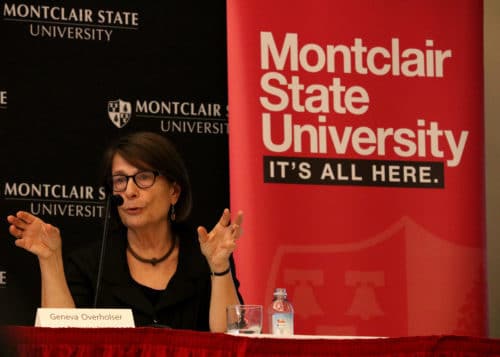
Geneva Overholser, Senior Fellow at Democracy Fund, speaks on the panel during the 2016 Sustain Local Conference held on 10/7/16 at Montclair State University by the Center for Cooperative Media.
Photo Credit: Kimmie Devereux
The Center for Cooperative Media at Montclair State University held its third Sustain Local national conference. This event focused on what local news outlets can do to survive and even thrive in an ever-changing news industry.
The conference began on Thursday evening with a networking reception hosted by the American Press Institute (API). API’s Liz Worthing gave a welcome presentation and was followed by Gordon Borrell, the CEO of Borrell Associates, who gave the keynote speech.
“I’m really afraid for journalism,” Borrell said. He talked about the shift to digital that media has seen and the need for outlets to understand the change and adapt. Borrell also spoke about his going from a reporter, to becoming an advertiser and the importance of newspapers working with their advertisers, to help them succeed, so that they will continue to advertise.
Borrell’s presentation set the stage for the rest of the conference on Friday. The day started at 8 a.m. and worked its way past 5 p.m., filled with speakers and workshops. The morning keynote consisted of a panel that discussed business models in journalism at the local level and what comes next.
The audience was comprised mostly of professionals working in the industry, or who have worked in the industry. Some Montclair State staff and faculty were also in attendance, as well as a handful of students, to whom the conference was free to attend.
“I thought it was great,” said Montclair State Professor Thomas Franklin speaking about the conference, “it’s important to have discussions about local journalism and local reporting. I think it’s important to have people share their stories of success and failure.” He feels that while focus is often on global or national issues, local journalism is an important part of journalism. And, it’s especially important for students to have access and be able to see these kinds of presentations and discussions.
The first set of workshops included one on monetization strategies, nonprofit business models, and “What’s next? A peek into the future of business models supporting local journalism”. “What’s next,” was a panel moderated by Bryan Mercer, Executive Director of the Media Mobilizing Project with Robertson Barrett, President of Hearst Newspapers Digital Media; Jim Friedlich, Director at Institute for Journalism in New Media; and Jeff Jarvis, Director of the Tow-Knight Center for Entrepreneurial Journalism, CUNY Graduate School of Journalism. Each panelist started off by telling the audience what they personally felt was next in terms of business models for local journalism.
“Start not with content,” said Jeff Jarvis, echoing Barrett and Friedlich’s responses, “start with the community and the communities needs.” Jarvis, spoke about local media outlets first finding out what’s important to the community they serve and what people are interested in, then generating content based on that. In his community of Philadelphia, Bryan Mercer had started a radio to help taxi drivers – because taxi drivers are in their cars all day, and it worked.
Planning for the conference began immediately after last year’s conference in Newark. Prior to this conference, there were two local summits that took place and the CCM used the feedback from the summits to help shape the agenda and figure out what areas to focus on for this year’s national conference. “I thought it was a success,” said Joe Amditis the Coordinator for CCM, “the lineup was fantastic; we had some really smart people there who just really know their stuff.And it’s always great to get a bunch of smart people in a room and have them talk about things that they’re passionate about.”
A part of the conference’s success also came in the technical aspect, which was more of Amditis’ area of focus for conference preparations. They used the new Mevo camera by Livestream for the Facebook livestream of the conference in each of the workshop rooms. He wanted to see if they could use them to essentially accomplish what would have taken a multi-camera setup. The Mevo allowed them to simulate a multi-camera environment, with one camera, and it worked, “that was great, that was a success in my book,” said Amditis.
After the first round of workshops was the lunchtime keynote. Merrill Brown, Director of the School of Communication and Media at MSU sat with Michael Oreskes, Senior Vice President of News at National Public Radio. Oreskes explained that public radio is a network of locally owned and operated, publicly licensed radio stations that now do many other things besides simply broadcast radio. “We [at NPR] are completely convinced that the strength of the network, is the local roots of each of our 264 member stations,” said Oreskes, “and that’s the thing we’re trying to build from.” According to Oreskes, NPR is working with member stations to encourage them to build up their capabilities for journalism and for engaging with their local communities in various ways and remembering that radio was one of the original community engagement mediums. For NPR, a strong network of local stations reporting on local news, also helps them with their international coverage.
Following the lunchtime keynote discussion were two more rounds of workshops which covered diversifying revenue streams, and strategies to do so, to the importance of investing in a deep connection with your audience. Before the networking session that ended the day, last workshop was a panel discussion moderated by MSU Professor Tara George, who asked questions of four journalists who have started their own local news sites. The panelists talked about their work, and what they’ve done to run successful media outlets, but also cautioned the audience to make sure they have a passion for the work if they were thinking about starting their own outlet.



